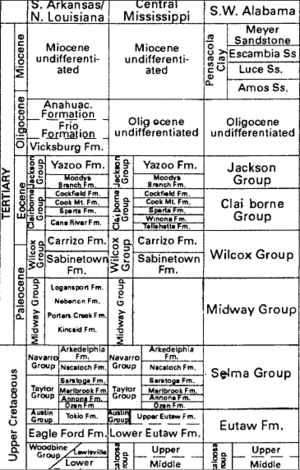Wilcox Group facts for kids
Quick facts for kids Wilcox GroupStratigraphic range: Selandian-Bartonian ~60–40Ma |
|
|---|---|
| Type | Geologic group |
| Unit of | Gulf of Mexico Basin |
| Sub-units | Calvert Bluff, Simsboro & Hooper Formations (Texas) Nanafalia, Hatchetigbee Formation (Alabama) |
| Underlies | Claiborne Group |
| Overlies | Midway Group |
| Thickness | up to 1,800 ft (550 m) |
| Lithology | |
| Primary | Mudstone, sandstone |
| Other | Siltstone, conglomerate, limestone, lignite |
| Location | |
| Location | Gulf Coast |
| Coordinates | 30°25′N 96°24′W / 30.417°N 96.400°W |
| Region | Alabama, Georgia, Louisiana, Maryland, Mississippi, North & South Carolina, Texas Nuevo León, Tamaulipas |
| Country | United States Mexico |
| Extent | Maryland to Tamaulipas |
| Type section | |
| Named for | Wilcox, Texas |
The Wilcox Group is a very important set of rock layers found in the Gulf of Mexico Basin. These rocks stretch from Mexico and Texas all the way to Louisiana and Alabama. The Wilcox Group formed a long, long time ago, between about 60 and 40 million years ago, during the Paleocene and Eocene periods. Scientists study these rocks to understand Earth's history and to find important resources like oil and gas.
What are the Wilcox Rocks Made Of?
The rocks in the Wilcox Group are mostly made of mudstone, which is like hardened mud. You can also find a lot of sandstone, which is rock made from sand. Sometimes, there are layers of lignite, which is a type of soft coal.
Other rocks found here include siltstone (finer than sand but coarser than mud), conglomerate (rocks with rounded pebbles), and limestone. The total thickness of these rock layers can be huge, from about 1,400 to 1,800 feet (425 to 550 meters) thick!
Where Did the Sand Come From?
Scientists have studied the sand in the Wilcox Group to figure out where it came from. They looked at tiny minerals called zircons inside the sand. These zircons act like tiny time capsules, telling us about their original source.
The sand traveled a very long way! It came from mountains and volcanoes located to the west, northwest, and southwest of the Gulf of Mexico. This includes areas like the Rocky Mountains and volcanic regions in northern Mexico.
Long ago, big mountains formed during an event called the Laramide orogeny. These mountains were a major source of the sand. This shows that the area where the Gulf of Mexico is now received sand from a much larger region than scientists first thought.
Why is the Wilcox Group Important for Energy?
The Wilcox Group is very important because it contains both source rocks and reservoir rocks. Think of source rocks as the "kitchen" where oil and natural gas are formed deep underground. Reservoir rocks are like "sponges" that can hold these oil and gas resources.
Scientists have found that oil and gas moved from older, deeper source rocks (from the Cretaceous and Jurassic periods) up into the Wilcox Group. This movement happened along cracks and breaks in the Earth's crust called faults. These faults acted like pathways, allowing the oil and gas to travel and collect in the Wilcox reservoir rocks. This is why the Wilcox Group is a key area for finding energy resources.


